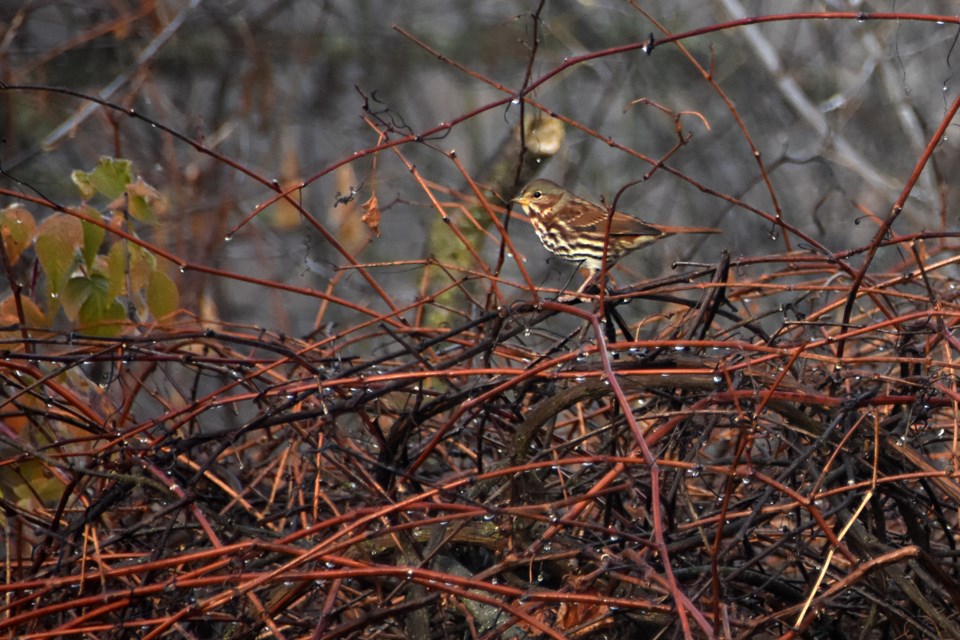The heavy post-dawn fog that enveloped our valley created a natural ‘haunted house’ feel to the landscape.
Dark skeletal trees loomed just barely within visual range, while the dead still air allowed dew drops to cling precariously to the dying tips of crispy vegetation. In other words, the perfect opportunity to grab the camera and go for a wander!
Now that we are collectively into the month of November, the landscape is definitely brown. That, and grey. Drab, boring, dreary, and potentially depressing, especially when compared to the riot of autumn colour that we recently experienced.
As I silently walked along the leaf-covered lane my eyes slowly became aware of, and then focused on, the subtle pallet found in the soggy foggy landscape: lined up along the fence rows were tall and weathered light brown and yellow grasses; reddish-brown weed stalks, heavy with seed, clustered in gossipy groups along the wayside.
Once upon a time (back through the mists of time, so to speak) I consulted with a wildlife artist I happen to know (and happen to be married to) and learned that these sombre colours can come in a wide array of tones, each with descriptive and mystic names. For example, the ubiquitous colour brown comes in several shades, with such earthy names as burnt sienna, raw umber and sepia.
If you look at an amateur's painting of a cottontail rabbit, what colour is the animal painted? Brown. And usually a uniform chocolate brown. However, there is very little chocolate brown on their fur, just a bit near the tip.
The rest of the hair's shaft has many blends of colour along it, ranging from light yellow to a brown so dark it is almost black. Not that every rabbit will let you get close enough to verify this but, believe me, the multi-hued browns are there.
During this bleak time of the year, we are treated to a visual reprieve as a multitude of berries, coloured red, white, orange or blue, are revealed to us as the plants are stripped of their covering foliage.
One of the challenges of locating these fruits is to beat the wildlife to them. For us the berries are but an ephemeral experience, but to many wildlife species their discovery marks the difference between death or survival. Whether the creature is migrating, preparing for hibernation, or adapting to winter conditions, any easy food is a welcome find.
One species that does produce very edible fall berries (according to some folks) is the wild grape. The hanging clusters of blue-black berries are unmistakable, as is the shaggy looking vine that supports the fruit. While a frost or two helps sweeten the grapes, always bear in mind that these are not the domestic stuff we enjoy from the supermarket. The tartness of the wild fruit is perhaps better enjoyed as a jelly, as opposed to eating them right off the vine.
As the grape vines are neared, there are several flutterings of small birds within the tangle of vines. The fog leaves them as silhouettes until I slowly, ever so slowly, approach the edge of the field. Now I can make out the feather patterns.
Juncos, with their white tail feathers flitting, just now arriving from their breeding grounds in northern Ontario, are joined with other northern visitors: white-throated sparrow, tree sparrow, and fox sparrow.
The fox sparrow is a treat to see as they are usually only observed in the spring migration when they stop in at our bird feeder. A second fox sparrow pops up from the shrubbery to enhance the experience.
As I study the tree sparrows the colour patterns found on their wings and backs are works of art, a wonderful blend of deep and light coloration. Notice too, that the rusty colours found on the birds match very closely the browns found in the surrounding vegetation. Very interesting, this camouflage technique.
As the sunlight begins to infiltrate the heavy mist, a few more colours are noted.
Little red berries abound in the autumn, and just trying to name them all can be a challenge. Winterberry, highbush cranberry, bittersweet nightshade, jack-in-the-pulpit, wintergreen and partridgeberry are scattered throughout local habitats.
The orange-coloured fruits of such plants as European bittersweet vine, mountain ash and feverwort are less often encountered; and blue cohosh and blue-bead lily certainly live up to their name. The white clusters of baneberry, also called doll's-eyes, nod as I tramp by them on my return through the hardwood bush.
Grey is that other dull November colour, a quiet blend of black and white. However, tree bark and rocks can reveal a wide range of colour shifts, with some species displaying a spectrum found only unto themselves.
Beech trees are an elephant grey, while aspens are a mix of yellow-grey, and grey-barked maples turn almost black when wet.
Great grey owls, grey jays and grey squirrels all rely on their namesake to assist them in hiding from, or sneaking up on, other wildlife species. Juncos, goshawks and shrews also utilize this bland colour to survive.
The sun has won the battle and the day is now well lit. The camera is replaced with a rake and I can now spend my time contemplating the hues, tones, and shades of the shriveled sugar maple leaves compared to the flat layers of burgundy infused red oak leaves. Always something to see.
